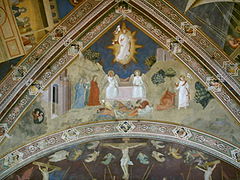
Back Resurrección de Jesús en el arte cristiano Spanish Kebangkitan Yesus dalam seni rupa Kristen ID Ressurreição de Jesus na arte cristã Portuguese

The resurrection of Jesus has long been central to Christian faith and Christian art, whether as a single scene or as part of a cycle of the Life of Christ. In the teachings of the traditional Christian churches, the sacraments derive their saving power from the passion and resurrection of Christ, upon which the salvation of the world entirely depends.[1] The redemptive value of the resurrection has been expressed through Christian art, as well as being expressed in theological writings.

However, the moment of the Resurrection is not described as such in the Gospels, and for over a thousand years it was therefore not represented directly in art. Instead at first it was represented by symbolic depictions such as the Chi Rho, the first two Greek letters of Christ, encircled by a wreath symbolizing the victory of resurrection over death.[2] Later various scenes that are described in the Gospels were used, and also the Harrowing of Hell, which is not. In Byzantine and later Eastern Orthodox art this has remained the case, but in the West the depiction of the actual moment of Resurrection became common during the Gothic period.
- ^ Erwin Fahlbusch, Jan Milic Lochman, Geoffrey William Bromiley & John Mbiti The Encyclopedia of Christianity, Volume 5 (2008) ISBN 0-8028-2417-X; p. 490
- ^ Ross Clifford, Philip Johnson, The Cross Is Not Enough: Living as Witnesses to the Resurrection. (Baker Books, 2012). ISBN 978-0-8010-1461-1; p. 95
© MMXXIII Rich X Search. We shall prevail. All rights reserved. Rich X Search